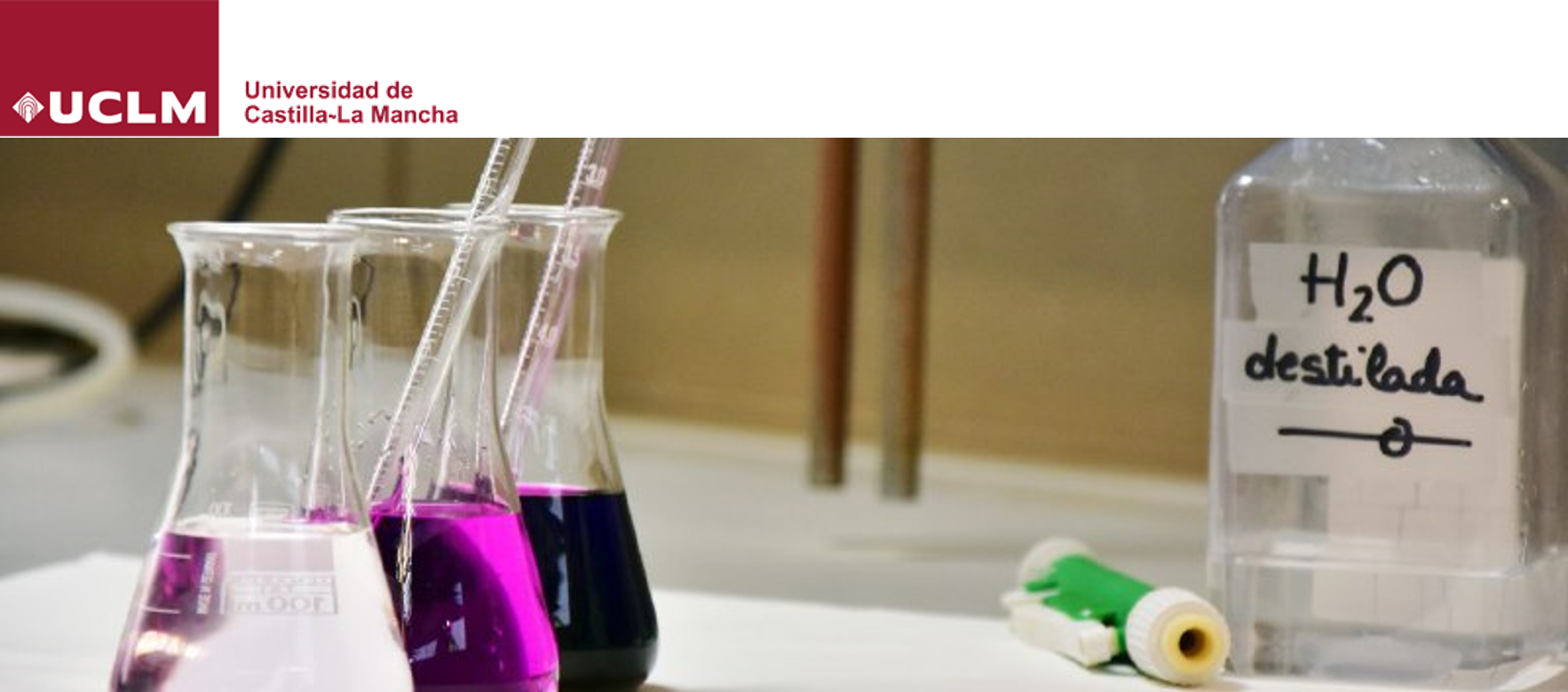Recent research publications
Novel Titanocene Y derivative with albumin affinity exhibits improved anticancer activity against platinum resistant cells Journal of Inorganic Biochemistry (2023) https://doi.org/10.1016/j.jinorgbio.2024.112520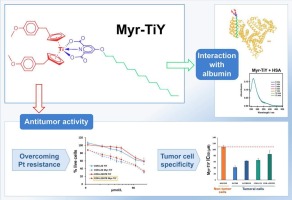
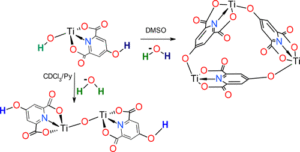 In this study we compare the properties of bis-cyclopentadienyl and monocyclopentadienyl titanium chelidamate complexes with the behavior of previously reported titanium dipicolinate derivatives. We have seen that the OH moiety in the chelidamate ligand does not increase the solubility of the titanocene complex in neutral D2O but allows its solubilization in basic media. In the case of monocyclopentadienyl complexes we have been able to isolate a titanium hydroxide compound that evolves in DMSO solution to render a neutral trimetallic cyclic architecture in which the chelidamate ligand behaves as an organic linker. Moreover, in the presence of a base, in CDCl3, that compound reacts to yield a dimetallic oxide. The hydroxide compound also can be deprotonated with NaOH to render a water soluble Ti-Na heterometallic complex that crystallize as a linear polymer. The theoretical calculations reveal that the two hydroxyl groups of that compound show significant differences on their nucleophilic and electrophilic character that can justify its reactivity in polar media.
The Role of Ancillary Ligands on the Reactivity of Monocyclopentadienyl Tantalum
In this study we compare the properties of bis-cyclopentadienyl and monocyclopentadienyl titanium chelidamate complexes with the behavior of previously reported titanium dipicolinate derivatives. We have seen that the OH moiety in the chelidamate ligand does not increase the solubility of the titanocene complex in neutral D2O but allows its solubilization in basic media. In the case of monocyclopentadienyl complexes we have been able to isolate a titanium hydroxide compound that evolves in DMSO solution to render a neutral trimetallic cyclic architecture in which the chelidamate ligand behaves as an organic linker. Moreover, in the presence of a base, in CDCl3, that compound reacts to yield a dimetallic oxide. The hydroxide compound also can be deprotonated with NaOH to render a water soluble Ti-Na heterometallic complex that crystallize as a linear polymer. The theoretical calculations reveal that the two hydroxyl groups of that compound show significant differences on their nucleophilic and electrophilic character that can justify its reactivity in polar media.
The Role of Ancillary Ligands on the Reactivity of Monocyclopentadienyl Tantalum
The Role of Ancillary Ligands on the Reactivity of Monocyclopentadienyl Tantalum Complexes with Water ChemistrySelect, 2017, 2, 1871. DOI: 10.1002/slct.201700164
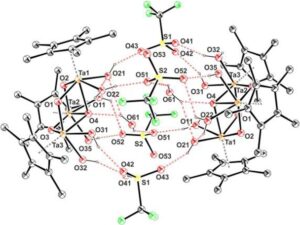 This work highlights the effect of ancillary ligands on the reactivity of monocyclopentadienyl tantalum complexes towards water. Based in our results, the citrate group is suitable for the stabilization of tantalum complexes in water.
This work highlights the effect of ancillary ligands on the reactivity of monocyclopentadienyl tantalum complexes towards water. Based in our results, the citrate group is suitable for the stabilization of tantalum complexes in water.
Effect of Anions on the Stability and Solubility of Tantalum Complexes in Water
Organometallics, 2015, 34 (1), pp 127–132. DOI:10.1021/om501014v
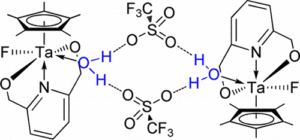
Parallel to the widespread interest in the chemistry of early transition metal cationic derivatives, weakly coordinating anions have been a subject of considerable attention on account of the noninnocent role they play in the reactivity and catalytic activity of metal complexes. In earlier works we have found that using the pincer-like ligand 2,5-pyridinedimethoxide and a triflate counteranion it is possible to stabilize water-soluble organometallic complexes of tantalum. Herein we describe the reactivity of a methyl-containing tantalum complex with Lewis and Brønsted acids to give the corresponding cationic complexes and some aspects of their reactivity related with the nature of the corresponding anions.
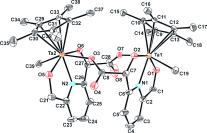 The cooperative metal–ligand activation of C–O bonds allows the functionalization of the pincer moiety to yield a variety of tantalum-bonded tetradentate ligands. We study the role of the ligand substituents on the selectivity of C–H bond cleavage processes.
The cooperative metal–ligand activation of C–O bonds allows the functionalization of the pincer moiety to yield a variety of tantalum-bonded tetradentate ligands. We study the role of the ligand substituents on the selectivity of C–H bond cleavage processes.
Insertion Reactions in Ta–H and Ta–Me Bonds in Complexes Containing Tridentate [κ3O,S,O]-Type Ligands Organometallics, 2013, 32 (6), pp 1752–1758. DOI: 10.1021/om3011728
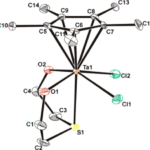 In recent years our research group has devoted significant attention to the relationship between the structural and electronic properties of multidentate ligands and the reactivity of the metallic center. A wide variety of homo- and heterofunctional multidentate ligands such as κ3-O,O,O, κ3-S,S,S, κ3-S,O,S, and κ3-O,S,O have been used to tune the reactivity of early transition metals such as tantalum. Herein we report the results of our most recent study on the preparation of a series of new alkyl and hydride tantalum−tdgol and −tbop complexes (tdgol = 2,2′-thiodiethanolate, tbop = 2,2′-thiobis(6-tert-octylphenolate)) and a comparative study on the reactivities of the methyl and hydride complexes in isocyanide insertion processes.
In recent years our research group has devoted significant attention to the relationship between the structural and electronic properties of multidentate ligands and the reactivity of the metallic center. A wide variety of homo- and heterofunctional multidentate ligands such as κ3-O,O,O, κ3-S,S,S, κ3-S,O,S, and κ3-O,S,O have been used to tune the reactivity of early transition metals such as tantalum. Herein we report the results of our most recent study on the preparation of a series of new alkyl and hydride tantalum−tdgol and −tbop complexes (tdgol = 2,2′-thiodiethanolate, tbop = 2,2′-thiobis(6-tert-octylphenolate)) and a comparative study on the reactivities of the methyl and hydride complexes in isocyanide insertion processes.
Rearrangement of Tridentate [OSO]-Type Ligands and Migratory Insertion Reaction Mechanisms in Cyclopentadienyl Tantalum Complexes Organometallics, 2012, 31 (20), pp 7052–7062. DOI: 10.1021/om3004652
 The mechanism of the isocyanide migratory insertion into the metal–carbon bond of monocylopentadienyltantalum dimethyl derivatives with [OSO] tridentate phenolate ligands has been investigated with DFT calculations. The presence of both a cyclopentadienyl and a tridentate ligand complicates a usually simple reaction, the migratory insertion reaction being coupled with a fac → mer rearrangement of the tridentate ligand. Two routes have been explored for the overall migratory insertion process, depending on the order of the fac → mer and insertion steps. Calculations show that the dissociative (first fac → mer rearrangement, then migratory insertion) and the associative (first migratory insertion, then fac → mer rearrangement) pathways are in principle competitive. However, electronic effects of the phenyl substituents can favor one of the pathways. The study also points out the influence of the donor atom, due to the inversion at the donor atom required in order to achieve the fac → mer interconversion.
The mechanism of the isocyanide migratory insertion into the metal–carbon bond of monocylopentadienyltantalum dimethyl derivatives with [OSO] tridentate phenolate ligands has been investigated with DFT calculations. The presence of both a cyclopentadienyl and a tridentate ligand complicates a usually simple reaction, the migratory insertion reaction being coupled with a fac → mer rearrangement of the tridentate ligand. Two routes have been explored for the overall migratory insertion process, depending on the order of the fac → mer and insertion steps. Calculations show that the dissociative (first fac → mer rearrangement, then migratory insertion) and the associative (first migratory insertion, then fac → mer rearrangement) pathways are in principle competitive. However, electronic effects of the phenyl substituents can favor one of the pathways. The study also points out the influence of the donor atom, due to the inversion at the donor atom required in order to achieve the fac → mer interconversion.
Ligand-Modification Effects on the Reactivity, Solubility, and Stability of Organometallic Tantalum Complexes in Water Chemistry, A Europenan Journal, 2012, 18 (8), 2319–2326. DOI: 10.1002/chem.201103026
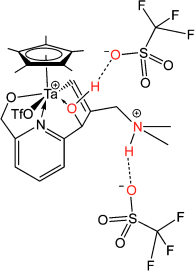 Ta Ta for now: C
Ta Ta for now: C![[BOND]](http://onlinelibrarystatic.wiley.com/undisplayable_characters/00f8ff.gif) C coupling processes on a tantalum-bound pincer ligand give rise to a series of tantalum derivatives with a variety of tetradentate ligands (see figure). The role of the ligand substituents on the reactivity and properties of the corresponding complexes is discussed.
C coupling processes on a tantalum-bound pincer ligand give rise to a series of tantalum derivatives with a variety of tetradentate ligands (see figure). The role of the ligand substituents on the reactivity and properties of the corresponding complexes is discussed.
ResearcherID: G-1924-2011 Scopus Author ID: 7402668814
